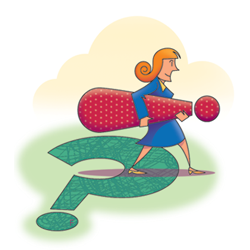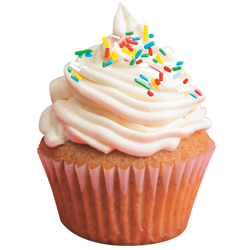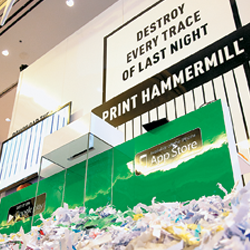A Touch of Pink
To promote new products and celebrate its 75th anniversary, Owens Corning Corp. draws in triple the crowds by inviting people to get their hands dirty.

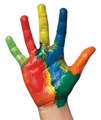
With nearly 1,500 exhibitors hailing from more than 100 countries, the International Builders' Show (IBS) is considered one of the largest home-building trade shows in the world. Not coincidentally, with that horde of companies showcasing products for the construction industry in more than 200 categories, IBS is also a veritable Shangri-La of seductive surfaces and tempting textures – supple and bendable stone veneers, marble-like vinyl flooring, wallpaper as crinkly as autumn leaves – all demanding to be stroked and smoothed, palmed and pawed.
Despite the show's surfeit of surfaces, Owens Corning Corp. had relied more and more on digital devices at IBS to transmit product information to the show's nearly 50,000 attendees. But the maker of Fiberglas-related building materials had come to realize that the returns from various interactive displays were diminishing. In 2011 and 2012 at IBS, for example, Owens Corning had employed sophisticated
interactive displays, including a 3-D interactive house. While the company stresses the displays were successful, it admits they didn't generate the leads or excitement it had hoped for.
Making Your Mark
If the interactive displays weren't generating the kinds of results Owens Corning desired, what would help it draw needed attention to its new products at the 2013 IBS, such as its EnergyComplete sealant and its Total Protection Roofing System? That year also marked the company's 75th anniversary, which increased Owens Corning's urgency to do something noteworthy that would mark the corporate milestone.
Some companies might have responded blindly to this by doubling down on more, not less, technology. But Owens Corning decided that instead of going techie, the best approach was going tactile instead. It wasn't a huge conceptual leap. After all, visitors to Owens Corning's exhibits had always found it difficult to restrain themselves from rubbing their hands all over samples of its famed insulation with the pastel-pink tint and the fluffy cotton-candy texture.
Together, Owens Corning and its exhibit house, Taylor Manufacturing Industries Inc. (The Taylor Group) of Brampton, ON, Canada, believed that combining tactile experience and physical activity would keep visitors engaged the longest and make the deepest impression on them. Thus, they reached out to someone renowned for working with her hands (or, to be more precise, her fingers). Kelly Sullivan, an artist known for collaborative paintings she dubs "FingerSmears," is famous for setting up canvases at events and trade shows for brands ranging from Johnson & Johnson to Old Navy. There, she supervises hundreds, sometimes even thousands, of attendees helping to create colossal works of art.
The plan for Owens Corning was simple: One individual after another would dip his or her fingertips into piles of paint on a palette, and then contribute a smear here or a smudge there to a canvas, following contours Sullivan had previously sketched of people or objects. While it might sound like roll-your-eyes New Age nonsense, there was real neuroscience behind the idea. "When we engage people through physical action, we involve more of their neurology than just viewing something," says Douglas Van Praet, a branding consultant and author of "Unconscious Branding: How Neuroscience Can Empower (and Inspire) Marketing." According to Van Praet, physical action can impress the brand more deeply into memory through our motor systems.
But what, exactly, would Owens Corning invite attendees to paint? After all, the company didn't want to waste what could be a powerful tactile activity on an uninspired, generic drawing. It wanted instead to use an image as indelibly linked to the company as Merrill Lynch & Co.'s stylized bull or Deere & Co.'s vaulting ungulate are to those corporate titans.
The answer the company came up with may be obvious to anyone who's ever seen the 130 movies and cartoons that featured a certain blush-colored feline in the last 50 years. First licensed by the company in 1980, the Pink Panther is so woven into popular culture that nearly 50 percent of people the company surveyed knew that the cool cat is associated with Owens Corning, and a full one-third of that number felt more favorably about the company simply because of it.
| To commemorate its 75th anniversary and draw people into its exhibit at the International Builders' Show, Owens Corning Corp. invited attendees to help in-booth artists paint a mural. |
In the Pink
Thus, when IBS opened its doors, the thousands of attendees who spilled onto the show floor like a rugby scrum saw a 5-by-10-foot canvas with the debonair cat's profile positioned near the entrance of the company's 40-by-50-foot booth. Sketched in black paint and drawn per Owens Corning's specs – two whiskers on each side, three fingers on each hand, and rectangular eyebrows – Sullivan's rendering of the iconic cat drew in attendees like a calorie-free Cinnabon would someone on a diet. With 15 people staffing the booth, and four more working solely with Sullivan, attendees poured into the exhibit to get their Matisse on.
They dipped their fingers into any of about 15 colors of acrylic paints kept on the palette, then flecked and smudged the canvas with fingertips that worked it like an Impressionist's brush. Hypnotically engrossed, they tinted and colored the celebrity cat, and surrounded him with flowers, houses, and a sun in colors as florid as a Tiffany lamp. Staffers in white smocks then assisted attendees in cleaning off the paint from their fingers – either by using a moist towelette or inviting them to wipe their fingertips on staffers' coats.
When they finished, attendees signed the edges of the canvas, leaving a permanent mark on the painting and creating a sort of autograph-laiden frame for the finished image. But the painters didn't just play Vermeer and then vamoose. They stayed for an average of 15 minutes, chatting with staffers about the company's products and anniversary milestone.
Every day, the simple activity attracted hundreds of attendees. Those who didn't participate in the painting assembled around the booth and looked on, fascinated by the tableau of amateur artists.
Owens Corning itself found something else that was equally captivating – measurable results. Coming into IBS, the company had set a goal of simply increasing booth traffic by an unspecified amount compared to the 2012 IBS, when a total of 434 attendees visited its exhibit. Aided by the manual activity that captivated its visitors' attention as much as their hands, Owens Corning attracted 1,470 attendees, more than tripling the previous year's figure. While a 75th anniversary is traditionally marked by presents of platinum, turning idle hands into de-facto paintbrushes turned out to be the best gift of all for Owens Corning.
Puzzle Box
By playing hands-on games with its
customers, Nimlok Co. wins a 275-
percent spike in booth traffic.

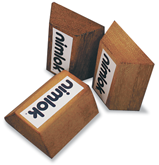
Exhibit managers know putting together a booth at a trade show can be kind of like assembling an insane jigsaw puzzle where some parts are missing, and those that aren't absent don't always fit together perfectly. Nimlok Co., a portable display and custom exhibit maker, knew that infuriating process better than most. Founded 44 years ago, the Niles, IL-based company addressed a need in the exhibition industry when it introduced its line of modular and portable displays that made exhibiting easier and cheaper for many in 1970.
So when the company planned its exhibit for EXHIBITOR2013, it wanted to communicate a message that was as simple as tic-tac-toe: Nimlok is an expert trade-show-puzzle solver. Conveying that concept, though, could be harder than doing Sudoku in hieroglyphics – especially when attendees wouldn't be able to handle a Nimlok system, since the company made a conscious decision not to display products, but to demonstrate its more abstract problem-solving skills instead.
After brainstorming various approaches such as "Are You Smarter Than a 5th Grader?" and "The Price is Right" spinoffs, Nimlok hit a critical juncture in its show planning. As fun and diverting as those trivia-based games might be, the company felt they didn't really illustrate the idea of problem solving. Nimlok determined it would be better to challenge attendees with puzzles demanding physical manipulation, thereby illustrating – in a very tactile way – the problem/solution concept.
 Game Plan
Game Plan
The company deliberately eschewed offering a version of, say, "Candy Crush" or "Minecraft" on a tablet, or some other interactive device. While 58 percent of Americans play video games, according to the Entertainment Software Association, games that require feeling and fondling objects with more atoms than pixels have a singular impact on the mind no mere visual can match.
"When you physically touch something, sensory areas in the brain are being activated that wouldn't be from a mere picture," says Roger Dooley, author of "Brainfluence" and the blog "Neuromarketing." So Nimlok opted to create in-booth contests where attendees would have to seize and manipulate real-world objects, requiring more brainpower – and by default, more of their undivided attention.
When the show opened its doors, Nimlok directed its staff to rustle up visitors cruising down the aisles. Clad in corporate colors staffers coaxed passersby to visit the 20-by-20-foot booth. Instead of the usual cajoling of attendees to come in for some unspecified and often uninteresting benefit, the staff used key phrases to pique the interest of passersby, such as "Nimlok solves your puzzles; now you have a chance to solve ours."
Pyramid Power
Once someone volunteered to play, the staffer scanned his or her badge while leading the attendee to a contestant station. On the show's first day, Nimlok pitted three attendees at a time against each other in a competition it called "Let your vision take shape." Standing behind their stations, players were given three trapezoidal wooden blocks and two minutes to create a pyramid with them. With game-show music playing in the background, the tuxedoed host signaled the start, and players competed with the intensity of Martha Stewart and the unbridled imagination of Frank Lloyd Wright. Wildly twisting and turning the 3-by-2-by-1-inch blocks, attendees raced to see who could finish first. And when a winner emerged, he or she received a branded version of the game to take home.
On the second day of the show, Nimlok relied on the formula Hollywood uses for sequels: Take the same elements you used before and supersize them. Basing the next day's hands-on contest on the game Jenga and calling it "Building your trade show foundations," the company presented each of two to four contestants at a time with a tower of Nimlok-branded 1.5-by-3.5-inch blocks. This time participants – drawn in by the same spiel as the first day – had just three minutes to remove blocks from the bottom of their towers, and place them at the top. Gamers grappled with the wood blocks like Greco-Roman wrestlers, moving and rearranging the pieces until, when the allotted time expired, the individual with the tallest wooden tower won the competition. Each player then took home a branded miniature Jenga game that, like the first day's prize, would serve as a tangible reminder of the booth, the activity, and Nimlok.
In-booth games took center stage in Nimlok Co.'s exhibit. Staffers used key phrases, such as "Nimlok solves your puzzles; now you have a chance to solve ours," to solicit participants.
Both games proved so popular that Nimlok ran them every 10 to 15 minutes resulting in approximately 40 contests per day. Roughly 250 people participated in the contests over two days, but hundreds more paused to watch the games in progress, at which time booth staffers engaged them in conversation about the vexing trade show puzzles they face and how Nimlok's solutions can help solve them. In the end, however, all that matters is whether the games helped the company meet its goals.
"Big results require big ambitions," Heraclitus once wrote, and Nimlok's ambition for the trade show was certainly large enough to impress the ancient Greek historian: achieve a 100-percent increase in attendance from the previous year. But the results bordered on epic – a 275-percent spike in the number of visitors. Hundreds of attendees played the games, but the results suggested that thanks to the power of touch, Nimlok emerged the winner hands down.
The Pause That Refreshes
Fred Beverages Inc. makes a splash by asking customers to play pingpong and pick its pockets – and gets picked up by a major distributor.

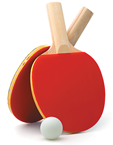
Trying to promote a product that has no taste, no smell, and no color could drive any sane marketer to drink. If you're Fred Beverages Inc., however, you find a way to do it with a touchable twist as quirky as Ariel Broggi, the Sausalito, CA-based company's cofounder, who believes mustaches are proven to boost creativity.
Even if its marketing department had more moustaches than Movember fueling its creativity, the company was a mere puddle trying to compete against the Pacific in the bottled-water market. Dominated by behemoth brands like Dasani and Fiji, the bottled-water industry nets $12 billion a year, according to the Beverage Marketing Corp. With bottled water's price tag per gallon often exceeding that of gasoline and sometimes wine, and Americans gulping about 60 percent more of the potable drink than in 2001, it's no wonder there are at least 40 players trying to be the biggest fish in this sea.
Wet and Wild
For Fred Beverages, that meant it needed to make waves with its Fred Water at the 2013 National Association of Convenience Stores (NACS) Show in Atlanta, which Exhibit Surveys Inc. ranks as the premier buying expo in the country. Among the 1,050 companies exhibiting were rivals such as Balance Water Co., which infuses its fluids with flower essences, and Neuro Brands LLC, whose waters promise to enhance your cognition with everything from vitamin A to zinc. Fred Beverages didn't have anything that smelled like a bouquet of jasmine or could boost attendees' IQ to Stephen Hawking levels, but its product did come in a cleverly designed container. Looking like a bootlegger's flask, the Fred Water bottle is shaped to slip easily into a back pocket, where you can reach around and locate it by touch before pulling it out. "Our big challenge was to communicate the benefits of the Fred bottle," Broggi says.
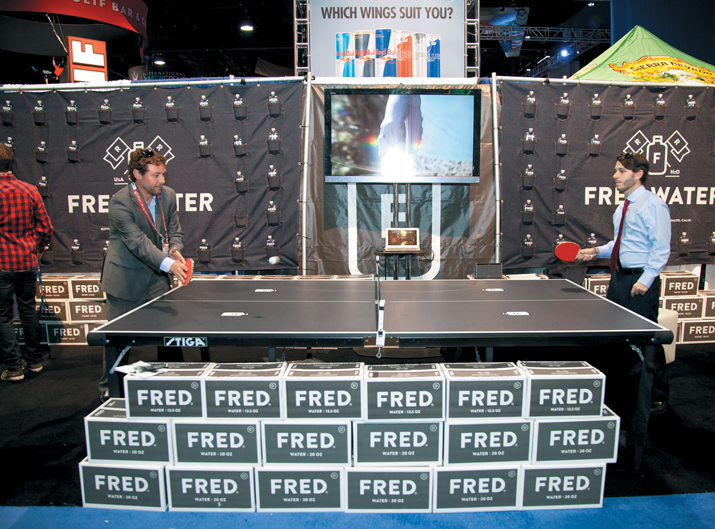 After retrieving flask-shaped water bottles from a wall of denim pockets in Fred Beverages Inc.'s exhibit, attendees picked up pingpong paddles for a spirited game of table tennis.
After retrieving flask-shaped water bottles from a wall of denim pockets in Fred Beverages Inc.'s exhibit, attendees picked up pingpong paddles for a spirited game of table tennis.
That basic distinction, setting it apart from competitors' near-universal tube-shaped containers, caused the proverbial light bulb to flick on over Broggi's head with the power of a supernova. His idea: Create a stylized version of the simple act of reaching for the bottle that would tempt attendees to get hands-on with its products. So the company located two 6-by-10-foot bolts of denim fabric, and
then hired a seamstress to hand cut and sew 32 jeans-like pockets into it, forming a pocket-clad back wall for the Fred Water booth. Attendees, the company hoped, would gravitate to
the denim and find the bottles in the pseudo pockets as alluring and intriguing as the enchanted container that urged "Drink me" was to Alice in Wonderland.
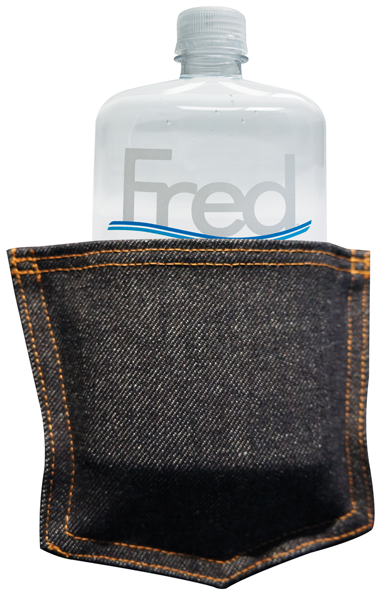
But a bunch of pockets wouldn't hold attendees' attention long enough for more substantial conversations about pricing and purchasing. So to keep interested prospects in
the exhibit long enough for staffers to strike up a conversation with them, Fred Beverages incorporated a second, equally tactile activity: pingpong. Positioned in front of the bottles-in-pockets display, a pingpong table became a dominant focal point inside the small 10-by-30-foot space, begging booth visitors to pick up a paddle.
Pick Pockets
The day NACS started, the 22,200 attendees who flooded the show floor found the company's 300-square-foot space far more intriguing than many of Fred Water's competitors. Draped over a 15-foot-long back wall were the bolts of blue denim, teeming with pockets full of the unmistakable Fred flasks. Hundreds of attendees deluged the booth, running their hands over the denim that, paradoxically, seemed as soft as a rose petal yet as rough as a brick. Grasping and pulling out the chilled bottles, the visitors fondled them throughout their visit to the booth, as if they were bewitched objects from a fairytale come to life.
While the staff of eight kept replenishing the quickly emptying pockets with new bottles, visitors stayed in the booth for up to an hour, chatting and playing pingpong, but always holding onto the unique bottles, clutching them like royal scepters.
"When someone touches an object, even for a short period, they immediately feel a sense of ownership," says Joann Peck, associate professor of marketing at the University of Wisconsin – Madison School of Business. "And whenever a person feels ownership, he or she values a product more." Indeed, four studies by Peck support her conclusion that running your fingers over an object can fasten a person's psychology to it. Moreover, the desire to purchase that item after touching it can follow automatically.
Attendees did come to value Fred Water more. While the company stays murky about its metrics for NACS, two things were as clear as its beverages: The company received 50 percent more traffic from key buyers than expected, and within a few weeks after NACS it won distribution in Kum & Go L.C.'s 400 convenience stores. Instead of frantically treading water in the wake of its bigger rivals at the show, the company used the power of a hands-on experience to make a huge splash. 




 With nearly 1,500 exhibitors hailing from more than 100 countries, the International Builders' Show (IBS) is considered one of the largest home-building trade shows in the world. Not coincidentally, with that horde of companies showcasing products for the construction industry in more than 200 categories, IBS is also a veritable Shangri-La of seductive surfaces and tempting textures – supple and bendable stone veneers, marble-like vinyl flooring, wallpaper as crinkly as autumn leaves – all demanding to be stroked and smoothed, palmed and pawed.
With nearly 1,500 exhibitors hailing from more than 100 countries, the International Builders' Show (IBS) is considered one of the largest home-building trade shows in the world. Not coincidentally, with that horde of companies showcasing products for the construction industry in more than 200 categories, IBS is also a veritable Shangri-La of seductive surfaces and tempting textures – supple and bendable stone veneers, marble-like vinyl flooring, wallpaper as crinkly as autumn leaves – all demanding to be stroked and smoothed, palmed and pawed.  Exhibit managers know putting together a booth at a trade show can be kind of like assembling an insane jigsaw puzzle where some parts are missing, and those that aren't absent don't always fit together perfectly. Nimlok Co., a portable display and custom exhibit maker, knew that infuriating process better than most. Founded 44 years ago, the Niles, IL-based company addressed a need in the exhibition industry when it introduced its line of modular and portable displays that made exhibiting easier and cheaper for many in 1970.
Exhibit managers know putting together a booth at a trade show can be kind of like assembling an insane jigsaw puzzle where some parts are missing, and those that aren't absent don't always fit together perfectly. Nimlok Co., a portable display and custom exhibit maker, knew that infuriating process better than most. Founded 44 years ago, the Niles, IL-based company addressed a need in the exhibition industry when it introduced its line of modular and portable displays that made exhibiting easier and cheaper for many in 1970.  Game Plan
Game Plan Trying to promote a product that has no taste, no smell, and no color could drive any sane marketer to drink. If you're Fred Beverages Inc., however, you find a way to do it with a touchable twist as quirky as Ariel Broggi, the Sausalito, CA-based company's cofounder, who believes mustaches are proven to boost creativity.
Trying to promote a product that has no taste, no smell, and no color could drive any sane marketer to drink. If you're Fred Beverages Inc., however, you find a way to do it with a touchable twist as quirky as Ariel Broggi, the Sausalito, CA-based company's cofounder, who believes mustaches are proven to boost creativity. 

